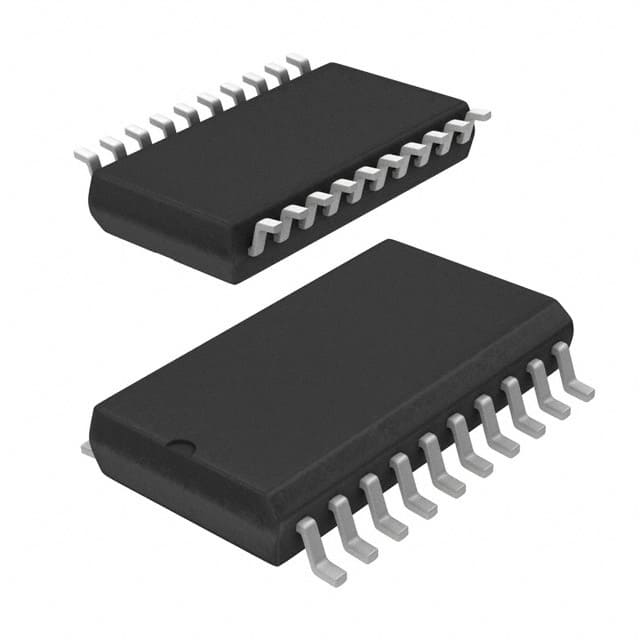Подробную информацию о продукте см. в характеристиках.

CD74HC377M96
Product Overview
- Category: Integrated Circuit
- Use: Flip-Flop
- Characteristics: High-Speed, CMOS Logic, 8-Bit Register
- Package: SOIC (Small Outline Integrated Circuit)
- Essence: The CD74HC377M96 is a high-speed CMOS logic integrated circuit that functions as an 8-bit register with flip-flop capabilities.
- Packaging/Quantity: Available in tape and reel packaging with 2500 units per reel.
Specifications
The CD74HC377M96 has the following specifications:
- Supply Voltage: 2V to 6V
- Logic Family: HC
- Number of Bits: 8
- Clock Trigger Type: Positive Edge
- Propagation Delay: 14 ns
- Operating Temperature Range: -40°C to +85°C
Detailed Pin Configuration
The CD74HC377M96 has a total of 20 pins. The pin configuration is as follows:
- CP (Clock Pulse Input)
- D0 (Data Input 0)
- D1 (Data Input 1)
- D2 (Data Input 2)
- D3 (Data Input 3)
- D4 (Data Input 4)
- D5 (Data Input 5)
- D6 (Data Input 6)
- D7 (Data Input 7)
- MR (Master Reset Input)
- Q0 (Flip-Flop Output 0)
- Q1 (Flip-Flop Output 1)
- Q2 (Flip-Flop Output 2)
- Q3 (Flip-Flop Output 3)
- Q4 (Flip-Flop Output 4)
- Q5 (Flip-Flop Output 5)
- Q6 (Flip-Flop Output 6)
- Q7 (Flip-Flop Output 7)
- GND (Ground)
- VCC (Supply Voltage)
Functional Features
The CD74HC377M96 offers the following functional features:
- 8-Bit Register: The integrated circuit can store and manipulate 8 bits of data.
- Positive Edge Trigger: The flip-flops are triggered by a positive edge clock pulse.
- Master Reset Input: The MR input allows for resetting the register to its initial state.
- High-Speed Operation: The CMOS logic ensures fast operation with minimal propagation delay.
Advantages and Disadvantages
Advantages of the CD74HC377M96 include:
- High-speed operation
- Versatile 8-bit register functionality
- Positive edge triggering for precise control
Disadvantages of the CD74HC377M96 include:
- Limited operating voltage range (2V to 6V)
- Propagation delay may impact timing-sensitive applications
Working Principles
The CD74HC377M96 operates based on the principles of CMOS logic. It utilizes flip-flops to store and manipulate 8 bits of data. The positive edge trigger ensures that the register updates its contents only when a rising edge is detected on the clock pulse input. The master reset input allows for resetting the register to its initial state.
Detailed Application Field Plans
The CD74HC377M96 finds applications in various fields, including:
- Digital Electronics: Used in digital systems for data storage and manipulation.
- Microcontrollers: Integrated into microcontroller designs for register-based operations.
- Communication Systems: Employed in communication systems for data buffering and synchronization.
- Industrial Automation: Utilized in industrial automation systems for controlling and monitoring processes.
Detailed and Complete Alternative Models
Some alternative models to the CD74HC377M96 include:
- SN74HC377: Similar 8-bit register with positive edge triggering, available in different package options.
- CD4013: Dual D-type flip-flop with similar functionality but different pin configuration.
- 74LS377: Octal D-type flip-flop with similar characteristics but operates at a lower speed.
These alternative models offer similar functionalities and can be considered as replacements for the CD74HC377M96 depending on specific requirements.
Word count: 436 words
Перечислите 10 распространенных вопросов и ответов, связанных с применением CD74HC377M96 в технических решениях.
Sure! Here are 10 common questions and answers related to the application of CD74HC377M96 in technical solutions:
Q: What is CD74HC377M96? A: CD74HC377M96 is a high-speed CMOS octal D-type flip-flop with 3-state outputs, commonly used in digital logic circuits.
Q: What is the operating voltage range for CD74HC377M96? A: The operating voltage range for CD74HC377M96 is typically between 2V and 6V.
Q: What is the maximum clock frequency supported by CD74HC377M96? A: CD74HC377M96 can support clock frequencies up to 74 MHz.
Q: How many flip-flops are there in CD74HC377M96? A: CD74HC377M96 consists of 8 flip-flops, making it an octal (8-bit) device.
Q: What are the 3-state outputs in CD74HC377M96 used for? A: The 3-state outputs allow multiple devices to be connected together without causing conflicts on the bus.
Q: Can CD74HC377M96 be used in both synchronous and asynchronous applications? A: Yes, CD74HC377M96 can be used in both synchronous and asynchronous applications depending on the clock input.
Q: What is the typical propagation delay of CD74HC377M96? A: The typical propagation delay of CD74HC377M96 is around 11 ns.
Q: Is CD74HC377M96 compatible with TTL logic levels? A: Yes, CD74HC377M96 is compatible with TTL logic levels, making it suitable for interfacing with TTL devices.
Q: Can CD74HC377M96 be cascaded to increase the number of flip-flops? A: Yes, CD74HC377M96 can be cascaded by connecting the outputs of one device to the inputs of another to increase the number of flip-flops.
Q: What are some common applications of CD74HC377M96? A: CD74HC377M96 is commonly used in applications such as data storage, address decoding, counters, registers, and general-purpose digital logic circuits.
Please note that the answers provided here are general and may vary depending on specific datasheet specifications and application requirements.

